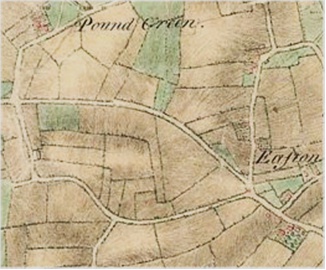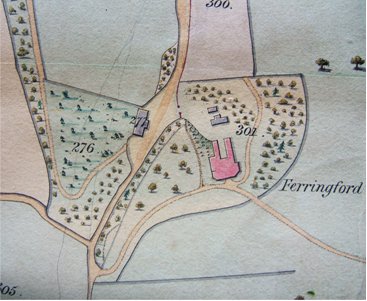The Poor Rate Books for Freshwater parish, spanning 1767 to 1844, can be used to identify a building date for Farringford. Until 1803, there is no mention of Farringford. The holding on which Farringford would be built was called “Walls”, after John Wall, a tenant, who held it in the 17th century. This holding was most probably based on what became Home Farm. It is also clear from both the John Andrews map (1769) and Ordnance Survey map (1792) that no building existed on the site until the present house was built.


In 1803, Edward Rushworth, whose main abode was Freshwater Farm, built (and therefore had to pay a poor rate on) “Faringford Lodge”. In 1804 it is called “Farringford Lodge”, and in 1805 it is “Farringfords.” During these years, Rushworth was living at Freshwater Farm, also known as Freshwater House, but in 1806 he made Farringford his main abode. The house then became known as “Farringford Hill”, and this remained its name until the mid-19th century. This is confirmed by the place of birth of Rushworth’s children: the first seven were all born at ‘Afton House’ while the rest were born at ‘Freshwater House’, with the last birth on 2 May 1804. Furthermore, leases and legal documents of the time consistently refer to Rushworth “of Freshwater House” until 1806; even in 1805, Rushworth is still described as living at Freshwater House. However, newspaper adverts in 1818 announcing the sale of Farringford clearly state that the house was built in 1802, in which case it must have been started in late 1802.
Why did Rushworth not live at Farringford Hill straight away? There is evidence to suggest that he provided the land for his daughter, Elizabeth, and her new husband, James Patrick Murray, to build a home. They were married on 31st January 1803 in Freshwater. However, in March 1804 James was posted to Ireland. While in Ireland the couple had three children who were privately baptised there, but had public baptisms at Freshwater church. Therefore, it is clear that they moved fairly often between Ireland and England, and presumably kept on Farringford until Edward Rushworth took over the running of the house and came to live there in 1806. Evidence suggests Rushworth assumed ownership of the property due to his son-in-law’s financial difficulties. James and Elizabeth Murray permanently moved to Athlone, Ireland, around 1810. Murray died at his home, Killenure House, in 1834.
The house at this stage most probably took the form of a square Georgian-style building, for use as a summer home or lodge. A typical Georgian window, complete with a flat arch, can be seen on the west side of the original house, partly obscured by the roof line of the southern wing, which abuts it: the edge of this window can still be seen under the roof at the east end of the loft space in the south domestic wing.
The window has been in-filled with brick and was the window for a first floor back bedroom. The two service wings (or at least the south wing) were originally only one storey high. The builder was a Mr. John Stephens of Yarmouth, who died in 1847 and is buried in Yarmouth. He also built Plumbley’s Hotel (now the Freshwater Bay House) for Charles Plumbley of Freshwater, a grocer, shortly after 1824.
Based on the ‘Analytical Record’ of Farringford by Robert Martin: